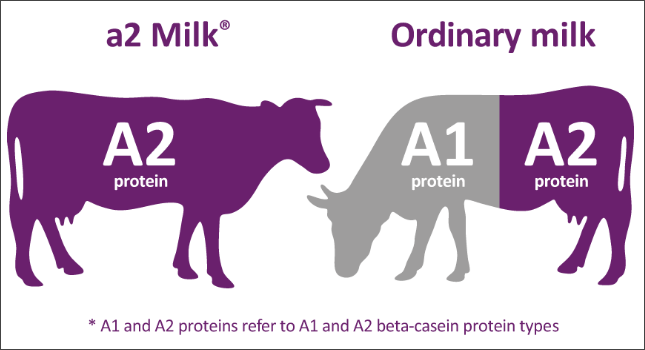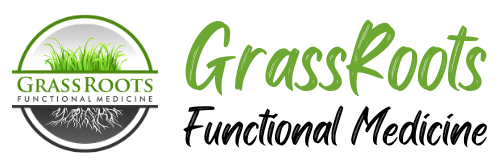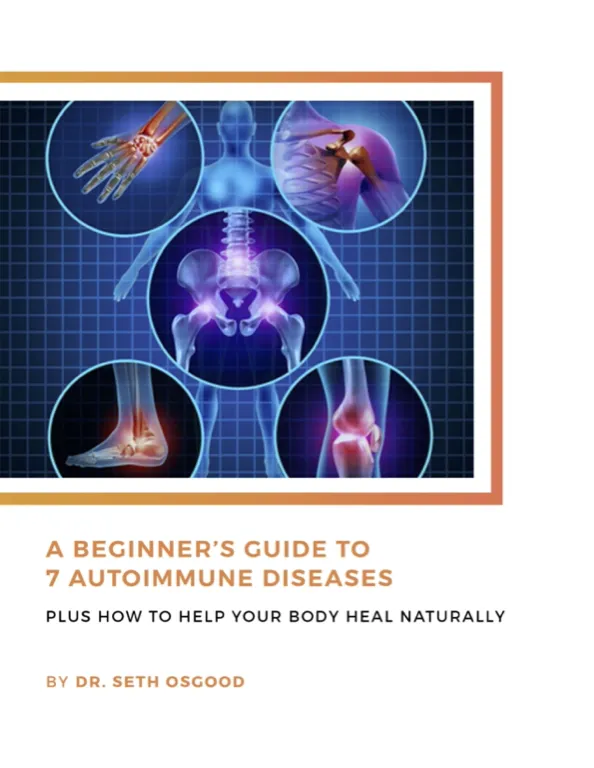Millions of people are ditching dairy and switching to alternatives like almond, soy, and coconut milk. But is this a good idea?
Eating a food your body doesn’t tolerate is like drinking a slow-acting poison every day. No one wants to do that! On the other hand, keeping variety in your diet is important. You don’t want to cut out an entire food group for no reason.
In order to make the best decision for your health, it’s important to weigh the nutritional benefits against the risks and take an individualized approach.
Here’s what you need to consider before cutting out dairy!
1. Dairy Can Be Highly Inflammatory & Trigger an Autoimmune Reaction
First, let’s talk about why so many people give up dairy.
Some are lactose intolerant, meaning they can’t break down a specific enzyme found in cow’s dairy (more on this below). This leads to pretty immediate digestive issues, namely gas, diarrhea, and abdominal cramping.
Many other people have a dairy protein sensitivity, meaning the proteins in dairy trigger an inflammatory reaction up to 72 hours after eating it. This can cause a variety of symptoms, including:
- Acne, eczema, and other skin issues
- Behavioral issues in children
- Bloating and gas
- Brain fog
- Diarrhea or constipation
- Fatigue
- Headaches
- Joint pain
- Mood imbalances
Over time, continuing to consume dairy when you have a protein sensitivity contributes to chronic inflammation and increases your risk for chronic disease.
Dairy proteins can also trigger an autoimmune reaction via molecular mimicry. This is the phenomenon where your immune system confuses two substances, such as dairy proteins and thyroid tissue, and attacks your own body by mistake.
2. Dairy is Full of Important Nutrients
Dairy isn’t all bad though! We all know that it contains calcium, but it’s also a rich source of vitamin D, vitamins B2 and B12, potassium, protein, and fat. However, not all dairy is created equal and this has a big impact on its nutrient content.
3. How Your Dairy is Produced Makes a Big Difference
Most of the milk, butter, and cheese lining supermarket shelves comes from conventionally raised cows and contains elevated levels of antibiotics and growth hormones.
Dairy cows are given a genetically engineered bovine growth hormone called rBGH to increase milk production. This hormone was developed by Monsanto, the same company that makes RoundUp. According to the Center for Food Safety, rBGH leads to a 25% increase in udder infections, which is why dairy cows are also given antibiotics. These hormones and antibiotics can make their way into your dairy products and then into your body.
A 2019 study published in Public Health Nutrition found that:
- Antibiotic residues were detected in 60% of conventional milk samples vs 0% of organic samples.
- Bovine growth hormone residue levels were found to be 20X higher in conventional milk than organic.
4. Organic, Grass-Fed Dairy Offers More Nutritional Value
Organic dairy cows are not given synthetic growth hormones and eat more grass. Because of this, organic milk contains more omega 3 fatty acids, more antioxidants, and a higher mineral content than conventional milk.
5. Lactose Intolerance is Not the Same as a Dairy Protein Sensitivity
There are two components of cow’s dairy that can cause issues for people – the sugar (lactose) and the proteins (casein and whey).
People who are lactose intolerant don’t produce the enzyme lactase, which is needed to break down lactose sugars. They often do better with raw milk, which is not pasteurized and contains enzymes not found in regular milk, including the enzyme that breaks down lactose.
People with a dairy protein sensitivity or allergy have a poor reaction to one or both of the proteins. Casein makes up 80% of dairy protein from cows and is structurally very similar to the proteins in gluten. So if you have a gluten sensitivity, you’re more likely to have a dairy sensitivity as well.
If you are in this group, you may have an easier time with dairy options that have a different protein makeup.
6. A2 Milk is Easier to Digest and Less Inflammatory for Some People
About 30% of the protein in cow’s milk is a form of casein called beta-casein. There are two variants of beta-casein – A1 and A2. Historically, cows produced milk that contained only the A2 form. Today, conventional milk contains mostly A1 proteins.
These A1proteins have been linked to stomach discomfort and symptoms such as gas, diarrhea, and cramping, whereas A2 proteins are more comparable to those found in human breastmilk and sheep and goat milk.
There is a brand called a2 Milk® that produces milk with only A2 proteins. A study in China found that people with known dairy issues who drank this type of milk did not experience digestive symptoms. The study also found that regular milk increased inflammation in participants, but the A2 milk did not.

Image Source: Food Navigator
7. You May Do Better with Goat or Sheep Dairy
Goat and sheep dairy are naturally free of A1 proteins and contain only the A2 form of beta-casein. Many people find that they tolerate this form of dairy better than cow dairy products. However, the two forms of protein are very similar so you may still have a poor reaction. This is why it’s important to test your reactions to various forms of dairy to find out which ones you tolerate best.
8. Raw Milk is a Safe, Nutrient-Packed Form of Dairy
Many people mistakenly believe that raw milk is dangerous due to unwarranted warnings from the FDA and CDC. Recent research has shown that the risks are actually very low. Instead, raw milk is a safe and healthy food that is packed with enzymes, fatty acids, vitamins, and minerals, since it is unprocessed and comes from grass-fed cows. My parents actually own an organic raw milk farm, so I can personally attest to the safety of drinking raw milk 🙂
In addition to having more nutrients and no added thickeners, shelf-stabilizers, or sugars, raw milk offers several health benefits. Studies show that it can reduce the risk of allergies and asthma in children, improve skin health, and fight H. pylori infections.
It is a great option if you find that you do tolerate dairy or if you are lactose intolerant since it contains the missing enzyme needed to break down lactose.
If you are in the Vermont area and want to give organic, grass-fed, raw milk a try, stop by my parents’ farm stand at 39 Cemetery Road, Corinth, VT 05039.

9. Dairy Alternatives Present Problems of Their Own
As people move away from cow’s dairy, many are embracing plant-based alternatives, including soy, almond, pea, oat, and coconut milk. However, these come with risks of their own to consider.
Soy contains chemical compounds called isoflavones that mimic estrogen and may contribute to estrogen dominance. Additionally, 94% of soy grown in the US is genetically modified. Almonds and peas can be inflammatory and problematic for those with an autoimmune condition. Oat milk is often cross-contaminated with gluten because oats are typically grown near wheat and processed in facilities that handle wheat products.
This is why I typically recommend coconut milk for those who tolerate it and need a safe plant-based milk alternative.
How to Decide if Ditching Dairy is Right for You
This is where individuality comes into play. What’s right for one person or even the majority isn’t always right for everyone. That’s why personalized care is at the core of functional medicine. You need to figure out what works for you as an individual.
Here is the process we use in my clinic to help patients discover whether or not dairy is a problem for them and which forms they tolerate best.
Step 1: Eliminate All Dairy for 30 Days
First, we have patients cut out all dairy products (cow, sheep, goat, A2, organic, etc.) for a full 30 days. This allows enough time for the problematic proteins to exit your system so that you can start the reintroduction trial with a clean slate.
Step 2: Reintroduce Specific Types of Dairy One at a Time
Next, we recommend introducing various forms of dairy one at a time to see how you respond to them. Here are the types of dairy we recommend that patients reintroduce and the order to introduce them in:
- Grass-fed ghee
- Organic goat or sheep dairy
- A2 milk
- Lactose-free cheese
- Homemade kefir, yogurt or fermented cream
- Raw milk
- Grass-fed butter
- Grass-fed milk
- Organic cheese
- Organic creams and dairy
Eat the test food three times on day one, then wait two days to see if you observe any symptoms. If you have a negative reaction, stop that food immediately and wait for your symptoms to return to baseline before introducing the next food on the list. After two days without the food, if there are no negative reactions, move on to the next item on the list.
If you have chronic health challenges and are struggling to pinpoint which foods are contributing to the problem, I also recommend working with a functional medicine practitioner who can look at your diet in the bigger picture and order appropriate testing, as well as a functional medicine nutritionist who can provide a personalized dietary plan.
In my clinic, patients work with myself, a functional nutritionist, and a health coach to identify the root causes of their symptoms, develop an individualized plan to address them, and receive the ongoing guidance and support to make the changes a way of life.
To learn more, head here to check out our Adaptation Program!
About the Author: Dr. Seth Osgood is a Doctor of Nursing Practice, Board Certified Family Nurse Practitioner and Institute of Functional Medicine (IFM) Certified Practitioner. Dr. Osgood received his post-graduate training in Functional Medicine through the IFM and from working with Dr. Amy Myers. He has helped people from around the world improve their health utilizing a Functional Medicine approach.
Want to work with Dr. Osgood and the GrassRoots team? Become a patient in our West Lebanon, New Hampshire Functional Medicine clinic, our Burlington, Vermont Functional Medicine clinic, or our Austin, Texas Functional Medicine clinic!






0 Comments